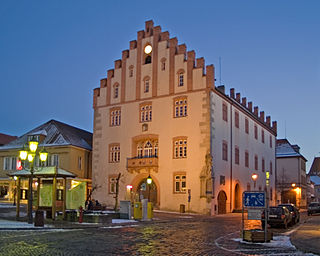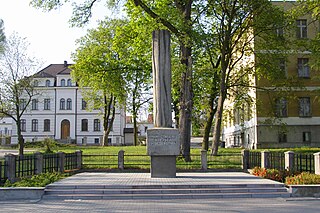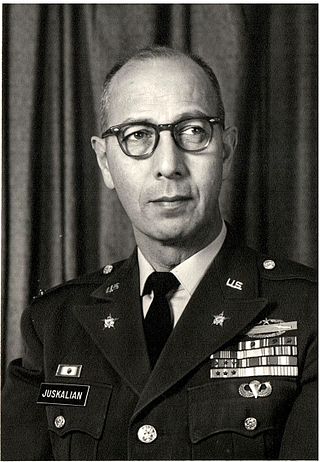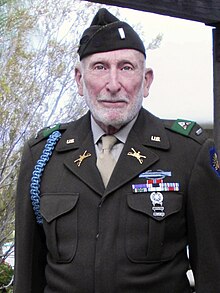
John Knight Waters was a United States Army four-star general who served as commander, U.S. Army, Pacific from 1964 to 1966. He was also the son-in-law of General George S. Patton. During World War II, he was taken prisoner while fighting in Tunisia in 1943, leading Patton to set up the controversial Task Force Baum to break him out.

Oflag XIII-B was a German Army World War II prisoner-of-war camp for officers (Offizierslager), originally in the Langwasser district of Nuremberg. In 1943 it was moved to a site 3 km (1.9 mi) south of the town of Hammelburg in Lower Franconia, Bavaria, Germany.

Hammelburg is a town in Bavaria, Germany. It sits in the district of Bad Kissingen, in Lower Franconia. It lies on the river Franconian Saale, 25 km west of Schweinfurt. Hammelburg is the oldest winegrowing town (Weinstadt) in Franconia.

Task Force Baum, also known as the Hammelberg raid was a secret and controversial World War II task force set up by U.S. Army General George S. Patton and commanded by Capt. Abraham Baum in late March 1945. Baum was given the task of penetrating 50 miles (80 km) behind German lines and liberating the POWs in camp Oflag XIII-B, near Hammelburg. Controversy surrounds the true reasons behind the mission, which most likely was to liberate Patton's son-in-law, John K. Waters, taken captive in Tunisia in 1943. The result of the mission was a complete failure; of the roughly 300 men of the task force, 32 were killed in action during the raid and only 35 made it back to Allied-controlled territory, with the remainder being taken prisoner. All of the 57 tanks, jeeps, and other vehicles were lost.

Oflag VI-B was a World War II German prisoner-of-war camp for officers (Offizerlager), 1 km (0.6 mi) southwest of the village of Dössel in Germany.

An Oflag was a type of prisoner of war camp for officers which the German Army established in World War I in accordance with the requirements of the 1899 Hague Convention, and in World War II in accordance with the requirements of the Geneva Convention (1929).
Oflag VII-B was a World War II German prisoner-of-war camp for officers (Offizierlager), located in Eichstätt, Bavaria, about 100 km (62 mi) north of Munich.
Oflag X-B was a World War II German prisoner-of-war camp for officers (Offizierlager) located in Nienburg/Weser, Lower Saxony, in north-western Germany. Adjacent to it was the enlisted men's camp (Stammlager) Stalag X-C.

Stalag VII-A was the largest prisoner-of-war camp in Nazi Germany during World War II, located just north of the town of Moosburg in southern Bavaria. The camp covered an area of 35 hectares. It served also as a transit camp through which prisoners, including officers, were processed on their way to other camps. At some time during the war, prisoners from every nation fighting against Germany passed through it. At the time of its liberation on 29 April 1945, there were 76,248 prisoners in the main camp and 40,000 or more in Arbeitskommando working in factories, repairing railroads or on farms.

Camp Fünfeichen was a World War II German prisoner-of-war camp located in Fünfeichen, a former estate within the city limits of Neubrandenburg, Mecklenburg, northern Germany. Built as Stalag II-A Neubrandenburg in 1939, it was extended by the officer camp Oflag II-E in 1940. After the Soviet takeover in 1945 until 1949 it was used as special camp, NKVD-camp Nr. 9 of the Soviet secret service (NKVD). Today, the site of the camp is a memorial.
Stalag IV-A Elsterhorst was a World War II German Army prisoner-of-war camp located south of the village of Elsterhorst, near Hoyerswerda in Saxony, 44 kilometres (27 mi) north-east of Dresden.

Oflag X-C was a German World War II prisoner-of-war camp for officers (Offizierlager) in Lübeck in northern Germany. The camp was located on the corner of Friedhofsallee and Vorwerkstrasse, close to Lübeck's border with the town of Schwartau, and is often cited as being located in Schwartau rather than Lübeck.
Stalag XIII-D Nürnberg Langwasser was a German Army World War II prisoner-of-war camp built on what had been the Nazi party rally grounds in Nuremberg, northern Bavaria.
Stalag XIII-C was a German Army World War II prisoner-of-war camp (Stammlager) built on what had been the training camp at Hammelburg, Lower Franconia, Bavaria, Germany.

Oflag 64 was a World War II German prisoner-of-war camp for officers located at Szubin a few miles south of Bydgoszcz, in Pomorze, Poland, which at that time was occupied by Nazi Germany. It was probably the only German POW camp set up exclusively for U.S. Army ground component officers. At most other camps there were several nationalities, although they were usually separated into national compounds.

Oflag XXI-B and Stalag XXI-B were World War II German prisoner-of-war camps for officers and enlisted men, located at Szubin a few miles southwest of Bydgoszcz, Poland, which at that time was occupied by Nazi Germany.

During World War II, Nazi Germany engaged in a policy of deliberate maltreatment of Soviet prisoners of war (POWs), in contrast to their general treatment of British and American POWs. This policy, which amounted to deliberately starving and working to death Soviet POWs, the bulk of whom were Slavs, was grounded in Nazi racial theory, which depicted Slavs as sub-humans (Untermenschen). The policy resulted in some 3.3 to 3.5 million deaths.

George Juskalian was a decorated member of the United States Army who served for over three decades and fought in World War II, the Korean War and the Vietnam War. Following graduation from Boston University, Juskalian entered the army as a second lieutenant in June 1936. During World War II, he served with the infantry during the North African Campaign and took part in Operation Torch. At the Battle of the Kasserine Pass, he was captured by German troops and became a prisoner of war (POW) for twenty-seven months. During the Korean War he commanded an infantry battalion. He was then stationed in Tehran where he acted an advisor to the Imperial Iranian Army throughout 1957 and 1958. During the Vietnam War, Juskalian once again undertook advisory duties, working with the South Vietnamese Army between 1963 and 1964, before serving as the MACV inspector general under General William Westmoreland.

Nazi Germany operated around 1,000 prisoner-of-war camps during World War II (1939-1945).
Uroš M. Tešanović was a Serbian officer and divisional general of the Royal Yugoslav Army during the April War in 1941 when Nazi Germany attacked and invaded the Kingdom of Yugoslavia. Before that, he served as the 25th Dean of the Academic Board the Military Academy where he also taught and authored military textbooks.












